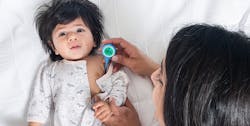Boom Time for Telehealth Devices
During the past few months, we’ve been focused on the existential threats to industry posed by COVID-19. But we should also remember that this kind of disruptive change also presents opportunities for those prepared to capitalize on them.
One of these is the sudden, unanticipated boost to telehealth services while hospitals have been forced to suspend normal operations to focus on COVID. Christopher McFadden, managing director of the investment firm KKR, says that, “We saw 10 years of telehealth adoption in about 8 weeks, ” and the same Forbes column cites a McKinsey report estimating that telehealth will grow from $3 billion in U.S. revenues before COVID-19 to a quarter trillion.
Part of that meteoric increase will be higher sales of so-called “Quantified Self” IoT devices, such as smart watches, which allow more and more people to accurately record their health and exercise data.
IoT-enabled telehealth devices demonstrate a point made many times before in this column. It’s a game changer when you can collect and share real-time data, rather than having to base response, whether to changes in assembly-line machinery or the human body, on hunches or historical data.
That’s a critical component of telehealth, because it gives caregivers objective information about patients’ daily life (vs. a few isolated tests in the doctor’s office) to diagnose and monitor compliance while unable to meet with patients. This data in patients’ hands may well result in a fundamental change in health care, empowering use into more of a partnership with caregivers.
To appreciate Quantified Health devices’ potential benefits and their transformative potential, one need only look at perhaps the least costly example, the Kinsa smart thermometer, typically priced around $30.
Inder Singh, former executive vp of the Clinton Foundation's Clinton Health Access Initiative, founded Kinsa Health in 2012, in part because his work reducing malaria in developing nations was always playing catch-up after an outbreak was well under way. Singh’s ahah moment was realizing the public health potential of creating a “smart” version of a thermometer, the one medical device almost everyone has. And if you have a thermometer, you use it: taking a sick family member’s temperature is the single most likely response to an illness.
The thermometer includes a communications chip which, if the user chooses to participate, automatically relays the fever reading and location (but no personal information, for privacy) to public health authorities for use in tracking outbreaks, particularly of flu. The accompanying app gives the user some basic care recommendations based on his or her fever.
More than a million Kinsa thermometers have been sold or donated around the world (including many that Lysol is buying for schools in low-income neighborhoods as part of its outreach programs). The company teamed with a statewide non-profit, Crush the Curve Idaho, and commercial sponsors, to get the thermometers to every school family in the state to reduce community spread of COVID.
In recent years the real-time user information has helped pinpoint areas of potential flu outbreaks 2-3 weeks earlier than CDC’s Flu Tracker could, by comparing the current rates to normal ones to isolate “atypical illness levels.”
During the height of the COVID-19 pandemic, Kinsa Health took an additional step, releasing a nationwide “Health Weather Map” created in conjunction with University of Oregon Assistant Professor Ben Dalziel. They believe the algorithm will identify COVID spikes up to 16 weeks before the current CDC alert system can, because 90% of those with COVID have fevers, and because the CDC must wait for data relayed from doctors’ offices and clinics. Equally important, the data is publicly accessible on real-time to anyone who wants to do independent analyses.
Despite (or, more accurately, because of!) its simplicity, this grassroots, thermometer-based system can potentially save thousands of lives.
Beyond the immediate crisis, there’s already another IoT-based telehealth device for a crucial and growing problem that also has been a focal point during the COVID crisis: diabetes. It gained even more importance as one of the key underlying factors increasing the risk of serious cases of COVID. According to CDC’s 2020 report, “34.2 million Americans — just over 1 in 10 — have diabetes.”
Most Type I diabetics must test their blood sugar levels 4 to 10 times a day by pricking their fingers and using a device to interpret the results, then injecting insulin if the levels have fallen too far. It’s uncomfortable and disrupts their daily lives. Worst of all, it means the diabetic is usually playing catch-up: manually injecting the insulin well after the blood sugar level has changed.
Now, there are two IoT-based devices that transform diabetes care. One, the Continuous Glucose Monitor (CGM), uses a tiny subcutaneous probe to automatically measure glucose levels every 5-15 minutes, 24-7, transmitting the data to a phone app where the levels and recommendations for management are visible (including sounding an alarm if the levels exceed pre-determined high or low levels).
Suddenly, diabetes care, as with so many other IoT devices, can switch to “predictive maintenance.” The patient gets new insights into how his or her diet and exercise affects levels and administers smaller doses when most effective, before a significant incident occurs. One system even links the CGM to an automated insulin pump, so that the pump automatically injects insulin, the precise amount depending on the readings from the CGM. That parallels IoT-based industrial predictive maintenance that does not require human intervention.
These two examples only scratch the surface of IoT-based monitoring and treatment systems to support telehealth. Many other conditions, especially chronic ones such as high-blood pressure, await clever entrepreneurial solutions. However, now that telemedicine has become accepted much more rapidly than anyone anticipated, the opportunity for companies to develop devices can save lives — and create profits.
W. David Stephenson, principal of Stephenson Strategies (Millis, Massachusetts), is an IoT consultant and thought leader. His The Future Is Smart (HarperCollins Leadership), was one of the first books on IoT strategy.
